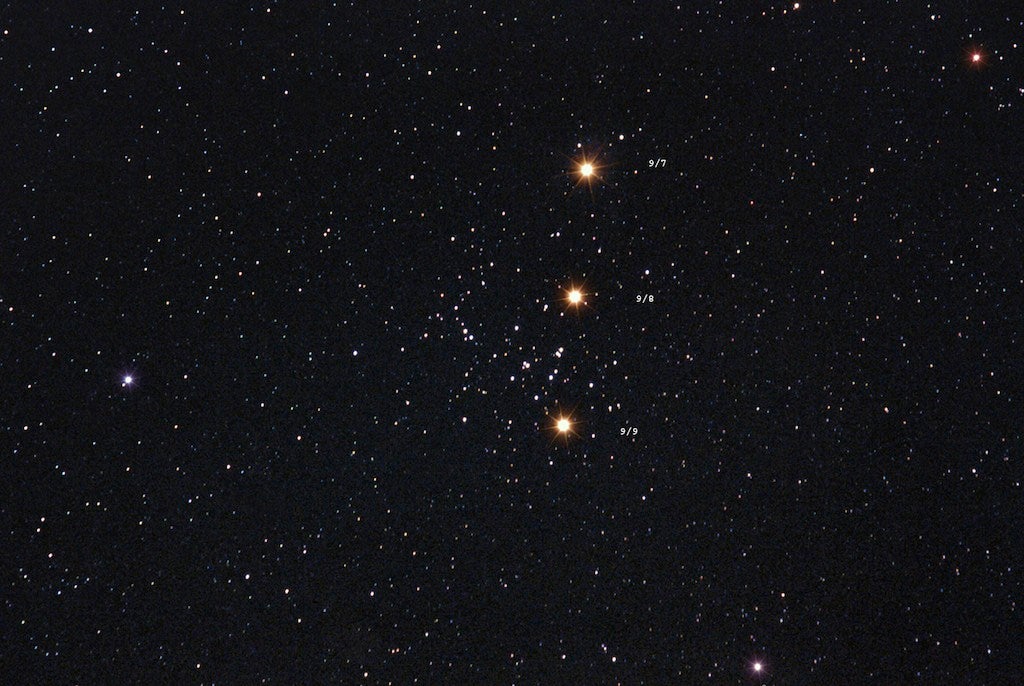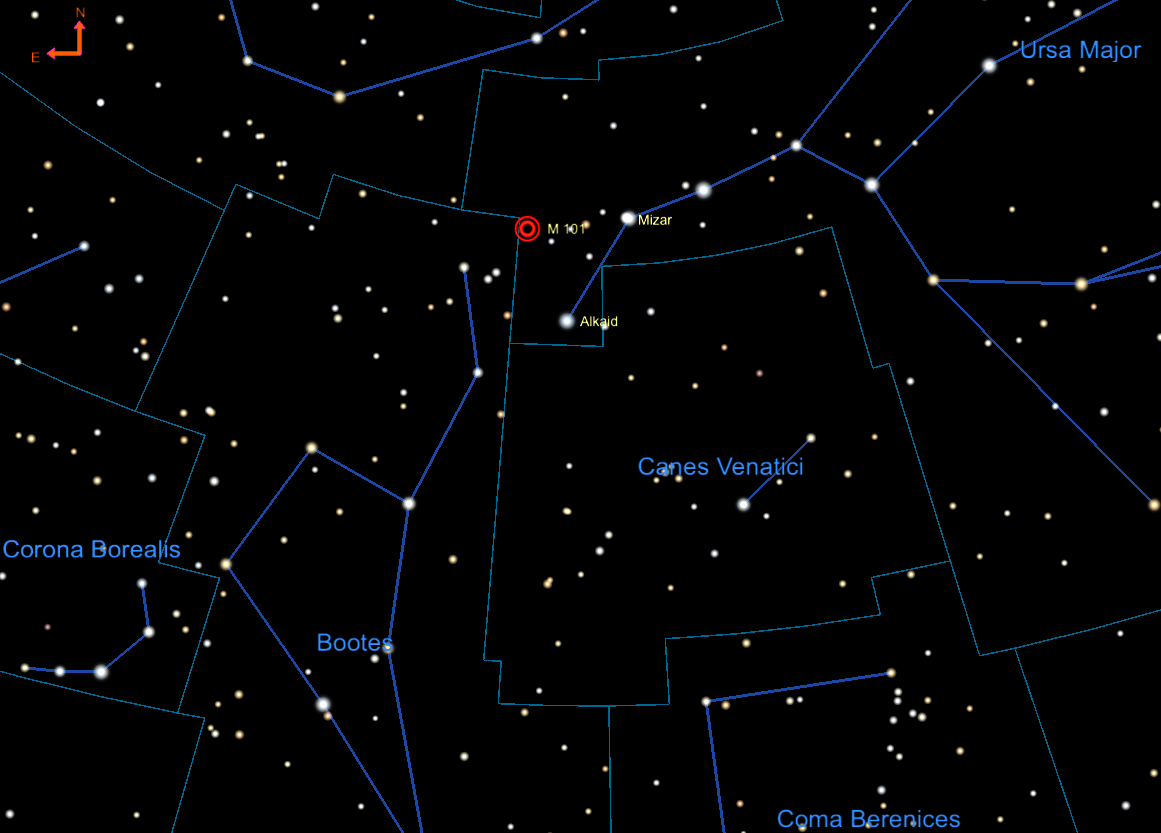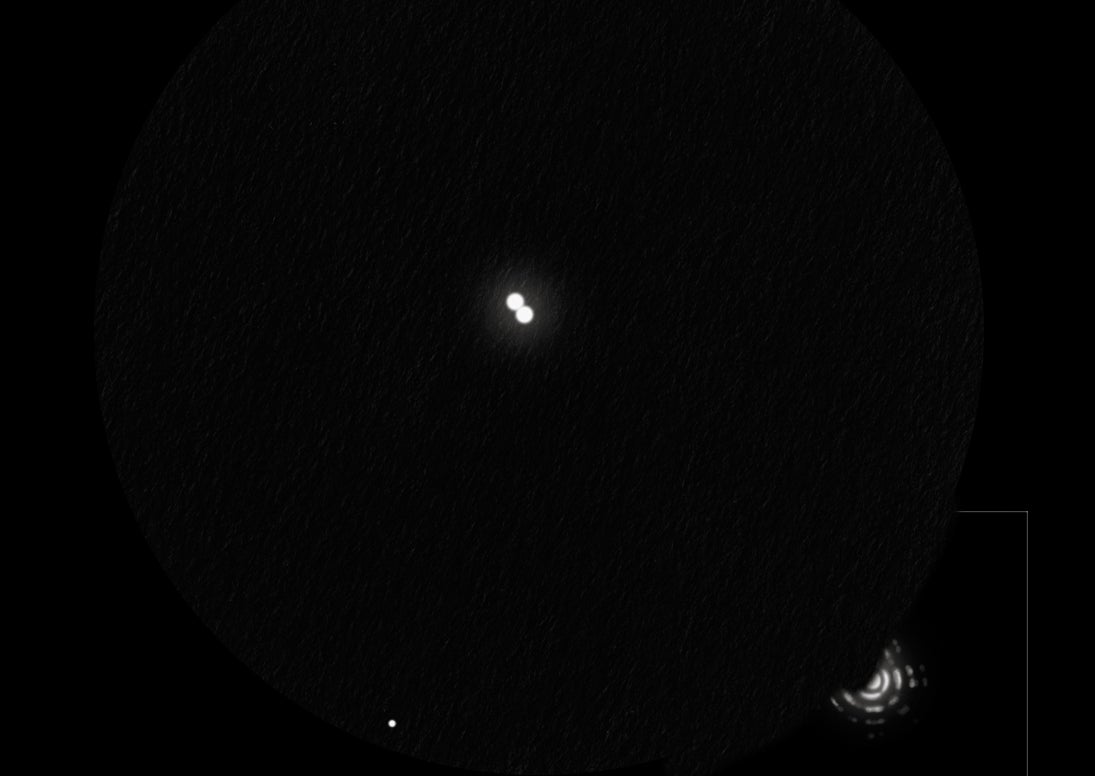
Friday, May 26
With the waxing Moon in the west after sunset, let’s concentrate our gaze east, where the cross-shaped constellation Cygnus is rising. About two hours after sunset, the Swan has sufficiently cleared the horizon for observers to seek out one of its many deep-sky treasures: The North America Nebula. Also cataloged as NGC 7000, this emission nebula sits just under 3.5° east of bright Deneb, the tail of the Swan. That makes it easy to find with binoculars or a telescope — and you’ll want to go for a wide-angle view, because NGC 7000 stretches some 2° across at its widest.
Take some time with this object and see whether you can pick out the familiar shape of its namesake continent — the Eastern Seaboard appears more prominent and sharply defined than the West Coast. Slip in a UHC filter if you have one to bring out the gas’ soft glow even more. Just west of the North America Nebula, across a narrow dark divide, is the Pelican Nebula (IC 5070). Although smaller at about 1° across, this is another worthy target to enjoy.
Both objects are popular astrophotography subjects as well. With a wide-angle view, you can capture the whole area in a single shot. The later you look, the better conditions will be as the area rises farther above the ground and the turbulent air that sits just above it.
Sunrise: 5:37 A.M.
Sunset: 8:18 P.M.
Moonrise: 11:38 A.M.
Moonset: 1:30 A.M.
Moon Phase: Waxing crescent (41%)
*Times for sunrise, sunset, moonrise, and moonset are given in local time from 40° N 90° W. The Moon’s illumination is given at 12 P.M. local time from the same location.

Saturday, May 27
First Quarter Moon occurs at 11:22 A.M. EDT. Our satellite is now traveling through Leo and sits just over halfway between the Lion’s heart (Regulus) and his tail (Denebola).
Before the Moon gets too much brighter, have you heard? There’s a new supernova visible in M101, the Pinwheel Galaxy in Ursa Major. To find magnitude 7.9 M101, first find the familiar shape of the Big Dipper. Follow the curving handle and stop at the end, identifying its last two stars: magnitude 2.2 Mizar and magnitude 1.9 Alkaid. These two stars create the base of a triangle; about 4.5° northeast of a point between them is M101.
This face-on galaxy has a low surface brightness, so if you want to see its spiral arms, you’ll need a large aperture. To find the bright supernova just southeast of its nucleus, however, all you’ll need is a small backyard instrument, about 4 to 4.5 inches. Look for what appears to be a bright star embedded in the grayish fuzz of the galaxy in your eyepiece — that’s the brilliant light of an explosion marking the end of a massive star’s life. Astronomers expect the supernova, which reached magnitude 11 earlier this week, to be visible through a telescope for months as it slowly fades.
Sunrise: 5:36 A.M.
Sunset: 8:19 P.M.
Moonrise: 12:39 P.M.
Moonset: 1:56 A.M.
Moon Phase: Waxing gibbous (51%)
Sunday, May 28
Saturn’s largest moon, Titan, lies due south of the planet this morning. The ringed planet rises around 1:30 A.M. local daylight time, but you’ll want to give it some time to climb above the horizon. About two hours before sunrise, you’ll find Saturn hanging 20° high in the southeast, glowing at magnitude 0.8 among the stars of Aquarius.
Zoom in with a telescope to spot magnitude 8.7 Titan to the planet’s south. Several other, fainter moons cluster closer to the planet’s stunning rings, including Enceladus and Dione to the east, and Tethys and Rhea to the west. See how many of these 10th- to 12th-magnitude moons you can catch in your eyepiece.
Those rings, of course, take center stage. They stretch nearly 40″ end to end, while the planet itself appears 17″ across. The ring system is now tilted toward us by only about 7°; this angle changes slightly throughout the year but overall is shrinking as the planet heads for an edge-on appearance in two years’ time.
While you’ve got your telescope out, swing over to the Circlet of Pisces and then drop down about 7° to land on the distant planet Neptune. Only visible through binoculars or a telescope, the magnitude 7.8 world sits just slightly north of the midpoint on a line drawn between 6th-magnitude 24 and 20 Piscium. Look for its slightly odd appearance: Not a bright pinpoint of light, but a small, circular, “flat” and grayish point.
Sunrise: 5:36 A.M.
Sunset: 8:20 P.M.
Moonrise: 1:40 P.M.
Moonset: 2:18 A.M.
Moon Phase: Waxing gibbous (60%)
Monday, May 29
Mercury reaches its greatest western elongation of 25° from the Sun at 2 A.M. EDT. It’s another early morning to catch it: The solar system’s smallest planet sits about 5° high just 30 minutes before sunrise. It’s glowing at magnitude 0.5 and brightening fast — in another week, it will be magnitude 0 and roughly the same height above the horizon half an hour before sunrise.
But this isn’t the only bright planet in the morning sky. To Mercury’s west (upper right) lies Jupiter, far brighter at magnitude –2.2. The king of planets stretches 34″ in a telescope — compare that with Mercury’s tiny 8″! See also if you can spot Jupiter’s four Galilean moons in the brightening sky: Europa lies to the planet’s west, while (closest to farthest) Io, Ganymede, and Callisto are east. You can start looking for them earlier than just before sunrise if you’re up, as Jupiter rises around 4 A.M. and is already a bit over 5° high an hour before sunrise.
Do make sure that, as always, you put away any optics several minutes before the Sun is scheduled to rise from your location, which can differ from the time we list as it’s heavily location dependent.
Sunrise: 5:35 A.M.
Sunset: 8:20 P.M.
Moonrise: 2:41 P.M.
Moonset: 2:39 A.M.
Moon Phase: Waxing gibbous (70%)
Tuesday, May 30
Venus passes 4° south of Pollux in Gemini at noon EDT; by dark, it is in roughly the same position. The bright planet also sits less than 1° from 4th-magnitude Kappa (κ) Geminorum, which will become visible as the sky darkens.
Venus is magnitude –4.4, unmissable in the sky. Through a telescope, its 22″-wide gibbous face is approaching half-lit, now appearing some 52 percent illuminated. Keep coming back to the planet over the next few days and record when you see it reach exactly half lit. Because of various effects, this can occur several days before or after the time it truly hits half phase late on June 3.
To Venus’ upper left (east) just one constellation over in Cancer is Mars. The magnitude 1.6 Red Planet reaches aphelion, the farthest point from the Sun in its orbit, at 5 P.M. EDT this afternoon. At that time, it will be 155 million miles (249 million kilometers) from our star. Mars is currently 1.5° from the stunning Beehive Cluster (M44) at the center of the Crab, just starting to skirt its edge. It will continue deeper into the cluster night by night, and we’ll be back before the week is out to check out the pairing.
Sunrise: 5:35 A.M.
Sunset: 8:21 P.M.
Moonrise: 3:44 P.M.
Moonset: 3:00 A.M.
Moon Phase: Waxing gibbous (78%)

Wednesday, May 31
Our quickly waxing Moon steals the spotlight tonight for telescopic observers as we target Mons Rümker in the Ocean of Storms. The Moon has moved east along the ecliptic day by day, sliding from Leo into Virgo, where it now sits some 8° east of the bright star Spica. We’ll be back to visit this constellation at the end of the week.
Located near the Moon’s northwestern limb, Rümker is just now coming out of shadow as the Sun rises over the lunar landscape. This isolated, ancient volcano appears lumpy and gently sloped, rather than sharp and jagged like a typical mountain. That’s because this mound rose from the floor slowly, built by upwelling lava rather than the devastating, quick-acting effects of a massive impact.
Just east of Rümker and likely easier to spot among lighter terrain is the bowl of Mairan Crater. About 25 miles (40 km) across, Mairan was formed about thousands of millions of years ago, yet retains a sharp, youthful rim.
Keep watching the area for a few hours and you may notice the sunlight creeping across the surface, shrinking the shadows as the Moon continues to wax toward Full.
Sunrise: 5:34 A.M.
Sunset: 8:22 P.M.
Moonrise: 4:49 P.M.
Moonset: 3:22 A.M.
Moon Phase: Waxing gibbous (86%)
Thursday, June 1
Mars is now fully embedded within the 1.6°-wide Beehive Cluster in Cancer. You can enjoy the lovely pair tonight as the sky turns dark after sunset and the stars of this young cluster begin to twinkle into view about 30° above the western horizon.
Also called M44, the Beehive is a relatively close-by (roughly 500 to 600 light-years) young cluster of stars known since ancient times, thanks to its naked-eye magnitude of 3.7. The bright red spot of Mars sits just west of the cluster’s center tonight; tomorrow, the planet will sit just east of it. Enjoy the view through binoculars or a low-power scope — too much magnification and you’ll cut out the stars in the cluster’s outskirts. Because the Beehive sits along the ecliptic, it’s often visited by planets, including bright Mars and Venus.
And speaking of, Venus has now pulled away from Kappa Geminorum just a bit and tonight sits just over 2.5° from this star, to the lower left of golden-hued Pollux. On the other side of the Beehive, to the east, lies the Sickle of Leo, anchored by the bright magnitude 1.4 star Regulus.
Sunrise: 5:34 A.M.
Sunset: 8:23 P.M.
Moonrise: 5:58 P.M.
Moonset: 3:46 A.M.
Moon Phase: Waxing gibbous (93%)

Friday, June 2
Let’s return to Virgo, again finding its 1st-magnitiude luminary, Spica. This star stands about 40° high in the south an hour after sunset. Spica’s blazing white light is a prominent sight in springtime evening skies — but, according to the late stellar astronomer Jim Kaler, that light is a little bit deceptive. Spica is not one star but two, orbiting each other every four days with only about one-tenth of the average Earth-Sun distance between them.
Because the two stars are so close, they can’t be split in your telescope. But there’s a nearby neighbor who can: Slide about 14.5° northwest of Spica to magnitude 2.7 Porrima (Gamma [γ] Virginis). This stunning pair of stars consists of two suns with nearly identical magnitudes that are currently several arcseconds apart. Astronomy contributor Raymond Shubinski likens them to “two tiny headlights in space.”
This pair completes an orbit once every 169 years, averaging about 43 times the Earth-Sun distance as they dance, though their highly elliptical orbit means they come much closer and grow much farther apart than this over the course of each orbit. Each is about 1.5 times as massive as the Sun.
Sunrise: 5:33 A.M.
Sunset: 8:23 P.M.
Moonrise: 7:11 P.M.
Moonset: 4:14 A.M.
Moon Phase: Waxing gibbous (97%)

Sky This Week is brought to you in part by Celestron.









